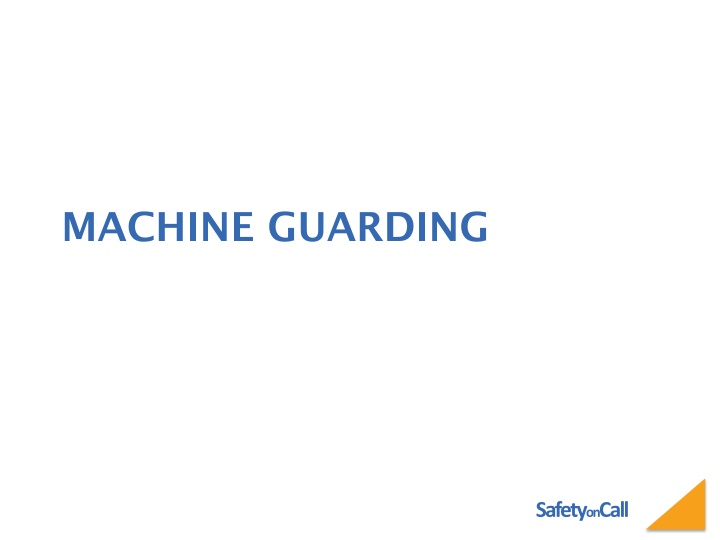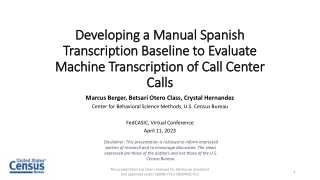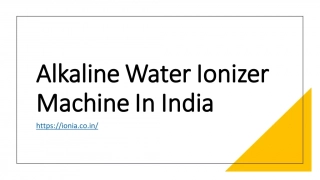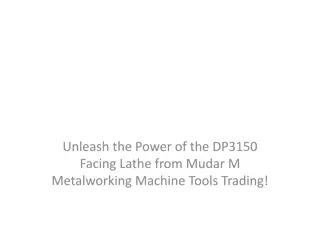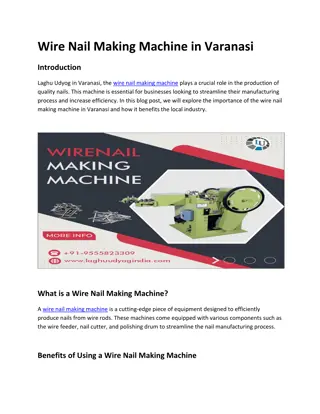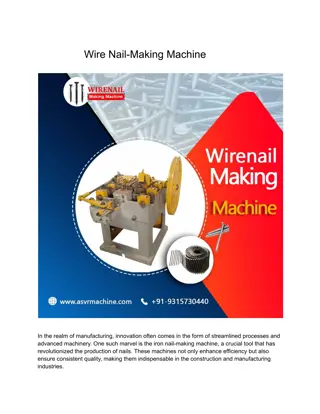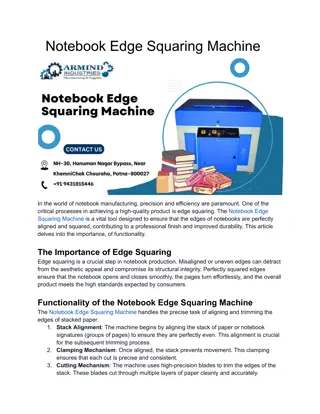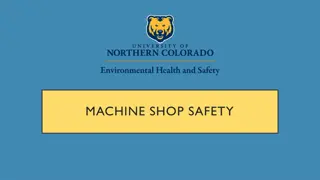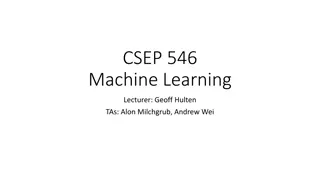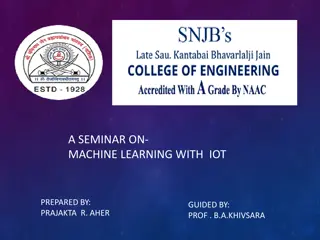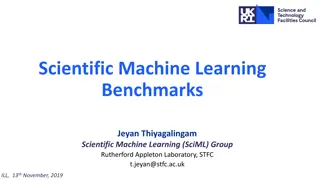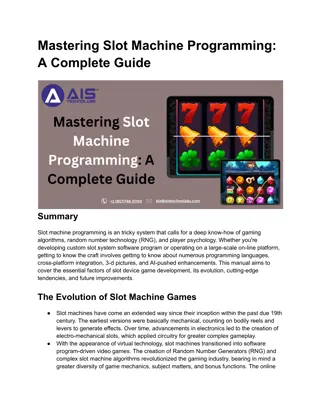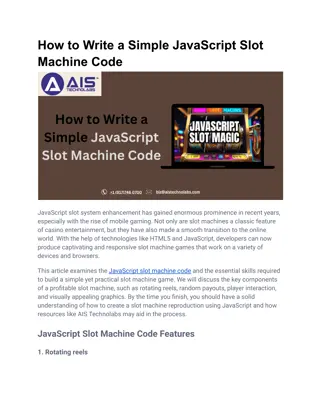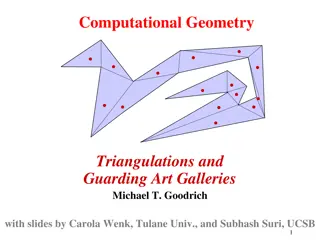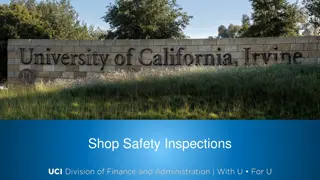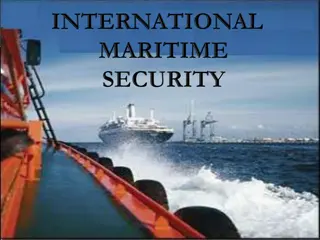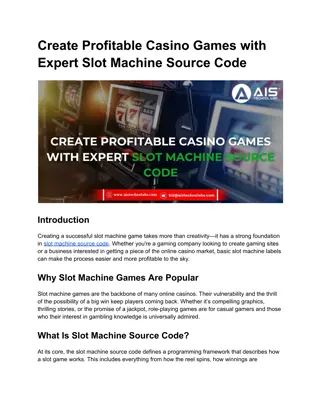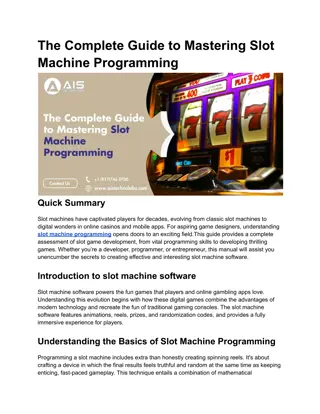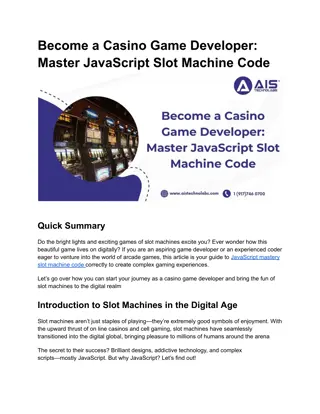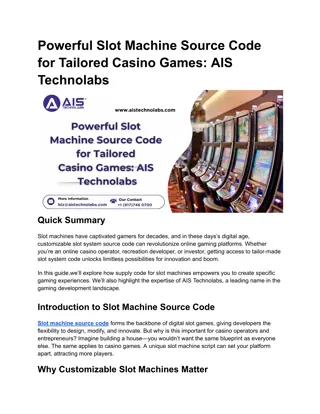MACHINE GUARDING
Prevent machinery-related injuries by safeguarding all hazardous machine parts and operations. Learn about the causes of accidents, mechanical hazards, and requirements for safeguards to protect workers effectively.
Download Presentation

Please find below an Image/Link to download the presentation.
The content on the website is provided AS IS for your information and personal use only. It may not be sold, licensed, or shared on other websites without obtaining consent from the author.If you encounter any issues during the download, it is possible that the publisher has removed the file from their server.
You are allowed to download the files provided on this website for personal or commercial use, subject to the condition that they are used lawfully. All files are the property of their respective owners.
The content on the website is provided AS IS for your information and personal use only. It may not be sold, licensed, or shared on other websites without obtaining consent from the author.
E N D
Presentation Transcript
MACHINE GUARDING SafetyonCall
INTRODUCTION Crushed hands and arms, severed fingers, blindness - the list of possible machinery-related injuries is as long as it is horrifying. Safeguards are essential for protecting workers from needless and preventable injuries. A good rule to remember is: Any machine part, function, or process which may cause injury must be safeguarded. Where the operation of a machine can injure the operator or other workers, the hazard must be controlled or eliminated. SafetyonCall
CAUSES OF MACHINE ACCIDENTS Reaching in to clear equipment. Not using Lockout/Tagout. Unauthorized persons doing maintenance or using the machines. Missing or loose machine guards. SafetyonCall
WHERE MECHANICAL HAZARDS OCCUR Point of operation. All parts of the machine which move, such as: Flywheels, pulleys, belts, couplings, chains, cranks, gears, etc. Feed mechanisms and auxiliary parts of the machine In-running nip points. SafetyonCall
POINT OF OPERATION That point where work is performed on the material, such as cutting, shaping, boring, or forming of stock must be guarded. SafetyonCall
ROTATING PARTS SafetyonCall
IN-RUNNING NIP POINTS Belt pulley Belt & pulley & Rotating cylinders Rotating cylinders Rack pinion Rack & pinion & Chain sprocket Chain & sprocket & SafetyonCall
REQUIREMENTS FOR SAFEGUARDS Prevent contact - prevent worker s body or clothing from contacting hazardous moving parts. Secure - firmly secured to machine and not easily removed. Protect from falling objects - ensure that no objects can fall into moving parts. Create no new hazards - must not have shear points, jagged edges or unfinished surfaces. Create no interference - must not prevent worker from performing the job quickly and comfortably. Allow safe lubrication - if possible, be able to lubricate the machine without removing the safeguards. SafetyonCall
METHODS OF MACHINE SAFEGUARDING Guards Fixed Interlocked Adjustable Self-adjusting Devices Presence sensing Pullback Restraint Safety controls (tripwire cable, two-hand control, etc.) Gates Location/distance Feeding and ejection methods Automatic and/or semi- automatic feed and ejection Robots Miscellaneous aids Awareness barriers Protective shields Hand-feeding tools SafetyonCall
FIXED GUARD Provides a barrier - a permanent part of the machine, preferable to all other types of guards. SafetyonCall
INTERLOCKED GUARD When this type of guard is opened or removed, the tripping mechanism and/or power automatically shuts off or disengages, and the machine cannot cycle or be started until the guard is back in place. Interlocked guard on revolving drum SafetyonCall
ADJUSTABLE GUARD Provides a barrier which may be adjusted to facilitate a variety of production operations. Band saw blade adjustable guard SafetyonCall
SELF-ADJUSTING GUARD Provides a barrier which moves according to the size of the stock entering the danger area. Circular table saw self-adjusting guard SafetyonCall
PULLBACK DEVICE Utilizes a series of cables attached to the operator s hands, wrists, and/or arms. Primarily used on machines with stroking action. Allows access to the point of operation when the slide/ram is up. Withdraws hands when the slide/ram begins to descend. SafetyonCall
PULLBACK DEVICE (CONTD) Hands in die, feeding. Point of operation exposed. Pullback device attached and properly adjusted. Die closed. Hands withdrawn from point of operation by pullback device. SafetyonCall
RESTRAINT DEVICE Uses cables or straps attached to the operator s hands and a fixed point. Must be adjusted to let the operator s hands travel within a predetermined safe area. Hand-feeding tools are often necessary if the operation involves placing material into the danger area. SafetyonCall
SAFETY TRIPWIRE CABLES Device located around the perimeter of or near the danger area. Operator must be able to reach the cable to stop the machine. SafetyonCall
TWO-HAND CONTROL Requires constant, concurrent pressure to activate the machine. The operator s hands are required to be at a safe location (on control buttons) and at a safe distance from the danger area while the machine completes its closing cycle. SafetyonCall
GATE Movable barrier device which protects the operator at the point of operation before the machine cycle can be started. If the gate does not fully close, machine will not function. Gate Open Gate Closed SafetyonCall
SAFEGUARDING BY LOCATION/DISTANCE Locate the machine or its dangerous moving parts so that they are not accessible or do not present a hazard to a worker during normal operation. Maintain a safe distance from the danger area. SafetyonCall
AUTOMATIC FEED (SHOWN ON POWER PRESS) Transparent Enclosure Guard Transparent Enclosure Guard Stock Feed Roll Stock Feed Roll Danger Area Danger Area Completed Work Completed Work SafetyonCall
ROBOTS Machines that load and unload stock, assemble parts, transfer objects, or perform other tasks. Best used in high- production processes requiring repeated routines where they prevent other hazards to employees. SafetyonCall
PROTECTIVE SHIELDS These do not give complete protection from machine hazards, but do provide some protection from flying particles, splashing cutting oils, or coolants. SafetyonCall
HOLDING TOOLS Used to place and remove stock in the danger area. Not to be used instead of other machine safeguards, but as a supplement. SafetyonCall
Some Examples of OSHA Machine Guarding Requirements . . . . Some Examples of OSHA Machine Guarding Requirements . . . . SafetyonCall
GUARDING FAN BLADES When the periphery of the blades of a fan is less than 7 feet above the floor or working level, the blades must be guarded with a guard having openings no larger than 1/2 inch. SafetyonCall
ABRASIVE WHEEL MACHINERY Work rests on offhand grinding machines must be kept adjusted closely to the wheel with a maximum opening of 1/8- inch to prevent the work from being jammed between the wheel and the rest, which may result in wheel breakage. SafetyonCall
ABRASIVE WHEEL MACHINERY The distance between the wheel periphery and the adjustable tongue must never exceed 1/4-inch. SafetyonCall
POWER-TRANSMISSION APPARATUS Unguarded belt & pulley Power-transmission apparatus (shafting, flywheels, pulleys, belts, chain drives, etc.) less than 7 feet from the floor or working platform must be guarded. SafetyonCall
MACHINE SAFETY RESPONSIBILITIES Management Ensure all machinery is properly guarded. Supervisors Train employees on specific guard rules in their areas. Ensure machine guards remain in place and are functional. Immediately correct machine guard deficiencies. Employees Do not remove guards unless machine is locked and tagged. Report machine guard problems to supervisors immediately. Do not operate equipment unless guards are in place. SafetyonCall
TRAINING Operators should receive training on the following: Hazards associated with particular machines. How the safeguards provide protection and the hazards for which they are intended. How and why to use the safeguards. How and when safeguards can be removed and by whom. What to do if a safeguard is damaged, missing, or unable to provide adequate protection. SafetyonCall
SUMMARY Safeguards are essential for protecting workers from needless and preventable machinery-related injuries. The point of operation, as well as all parts of the machine that move while the machine is working, must be safeguarded. A good rule to remember is: Any machine part, function, or process which may cause injury must be safeguarded. SafetyonCall
